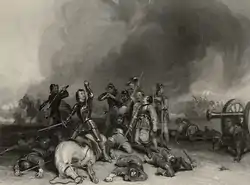James Tibbits Willmore | |
|---|---|
_-_1940P6_-_Birmingham_Museums_Trust.jpg.webp) Portrait of James Tibbetts Willmore | |
| Born | 1800 |
| Died | 12 March 1863 |
| Resting place | Highgate Cemetery |
| Occupation | Engraver |
James Tibbits Willmore ARA (Birmingham September 1800 – 12 March 1863 London) was a British engraver.[1][2]
Biography
He was born at Bristnal's End, Handsworth (then Staffordshire, now West Midlands). Contemporaneous authorities differ on the spelling of his middle name, as seen in the citations below.
His father, James Willmore, was a manufacturer of silverware. At the age of fourteen Willmore was apprenticed to the Birmingham engraver William Radclyffe. His younger brother Arthur Willmore (1814–1888) trained with him, and also became an engraver. Radclyffe had received drawing lessons in Birmingham from Joseph Barber. He married, and in 1823 he went to London where he worked for Charles Heath for three years. He later worked on the plates of William Brockedon's Passes of the Alps and Turner's England and Wales.[3]
He made engravings after Chalon, Leitch, Stanfield, Landseer, Eastlake, Creswick and Ansdell, and especially after Turner.[3] Willmore engraved thirteen pictures on copper for Turner's England and Wales series, beginning in 1828, and eight on steel for his Rivers of France. He made a number of large single plates after Turner, including Ancient Italy in 1842. The next year he exhibited this print at the Royal Academy (the first he had shown there), and was elected an associate engraver of the academy.[4]
He died on 12 March 1863 and is buried on the western side of Highgate Cemetery.[5]
Gallery
 Engraving of the 'Cascade at Terni' by James Tibbits Willmore after a drawing by Samuel Prout. Published 1830.
Engraving of the 'Cascade at Terni' by James Tibbits Willmore after a drawing by Samuel Prout. Published 1830. Ullswater, Cumberland Engraving by James Tibbits Willmore for Turner's Picturesque Views in England and Wales
Ullswater, Cumberland Engraving by James Tibbits Willmore for Turner's Picturesque Views in England and Wales Battle of Hopton Heath after George Cattermole (1800–1868)
Battle of Hopton Heath after George Cattermole (1800–1868) Three young boys are fishing in rock pools with a large net after W. Collins
Three young boys are fishing in rock pools with a large net after W. Collins 1833 engraving based on Charles Lock Eastlake's Lord Byron's Dream
1833 engraving based on Charles Lock Eastlake's Lord Byron's Dream Grave of James Tibbits Willmore in Highgate Cemetery
Grave of James Tibbits Willmore in Highgate Cemetery
References
- ↑ Gilman, Daniel Coit; Peck, Harry Thurston; Colby, Frank Moore (1909). "WILL´MORE, JAMES TIBBITS". The New International Encyclopædia. Vol. 20. p. 541.
- ↑ 'Obituary: Mr. James Tibbetts [sic] Willmore, ARA', The Art Journal, May 1863, pp. 87–88.
- 1 2 One or more of the preceding sentences incorporates text from a publication now in the public domain: Chisholm, Hugh, ed. (1911). "Willmore, James Tibbits". Encyclopædia Britannica. Vol. 28 (11th ed.). Cambridge University Press. p. 687.
- ↑ Joll, Evelyn; Butlin, Martin; Hermann, Luke, eds. (2001). The Oxford Companion to J.M.W. Turner. Oxford: Oxford University Press. p. 385. ISBN 0-19-860025-9.
- ↑ Cansick, Frederick Teague (1872). The Monumental Inscriptions of Middlesex Vol 2. J Russell Smith. p. 123. Retrieved 15 October 2021.
External links
- Works by or about James Tibbits Willmore at Internet Archive
- . Dictionary of National Biography. 1885–1900.
- Willmore's engraving of J. M. W. Turner's view of Nantes from Feydeau Island was published in The Keepsake annual for 1831, with an illustrative poem entitled
 The Return. by Letitia Elizabeth Landon.
The Return. by Letitia Elizabeth Landon.